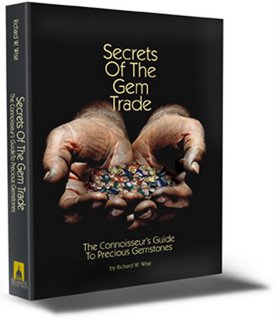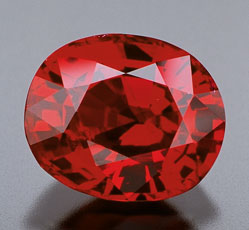LIGHT UP YOUR LIFE
Lighting and Grading Gemstones Part I
©2006
Richard W. Wise, G.G.
It used to be so simple, the brighter the light the better the light. You had the light from a fire and the light from the sun, that was it. In those good old days it was easy to figure out watt was watt! Today we have a myriad of options, “warm light”, “cool light”, “daylight.” Gem dealers are beginning to discover that the lights that make his rubies look like a pigeon’s blood may make his tourmaline look like a dog’s poop. As for the buyer, caveat emptor baby, check the bulb!
We are all familiar with the daylight standard: diamonds and colored gemstones are supposed to be judged in north daylight. Why?, because north daylight, specifically north daylight at noon is white light balanced between the red and blue spectrum. Sounds simple, but wait a moment! Dealers have long realized that the quality of daylight differs in locations throughout the world. North daylight at noon in Bangkok is qualitatively different from north daylight in New York.
The quality of natural daylight is affected by several factors, including latitude and air quality. In addition, the relative strength and color composition of daylight changes as the day progresses. “Don’t buy blue sapphire after 2:00pm“. That was the advice my Bangkok broker gave me on my first trip to Thailand. This dealer’s truism teaches a basic fact that as the day progresses the color composition of sunlight moves from yellowish into the blue range then toward red at sundown.
Color scientists measure color as a function of light temperature and express it in units called Kelvin (K). a light filament heated red will have a Kelvin temperature of 1000-1500K, orange like a candle flame has a color temperature of 1500-2500K, yellow between 2500-4000K, white as in daylight is defined as a range; 4000-10,000K. In practice, increasing Kelvin temperature reduces yellow and adds blue.
If we wish to get a true color rendering using the daylight standard we will want a bulb that produces average noon sunlight with its relatively balanced color spectrum with a color temperature between 5500-6500 Kelvin. Unfortunately, the Kelvin temperature of an incandescent lamp falls between 3000-3200. The new low-volt quartz halogens have a color temperature of only about 3200K. Light in this temperature range is distinctly yellowish and will enhance the look of stones in the yellow, orange and red range. It will add an attractive bluish hue to chromium-vanadium colored gemstones like emerald, chrome tourmaline and tsavorite garnet. However, some Emerald, particularly Zambian emerald, can look distinctly overblue in this type lighting and 3000k light tends to muddy the crystal (reduce the transparency) of iron colored green and blue stones such as tourmaline and sapphire.
Daylight equivalent lighting does exist in fluorescents but not in incandescent single point spot and flood lighting that is used by most dealers and jewelers to bring out the brilliance of a gemstone. Daylight fluorescent bulbs with Kelvin temperatures between 5500-6500 are available. These lamps are marketed, usually as “daylight” lighting by several companies under various trade names. Unfortunately fluorescent lamps generate a diffused light and produce insufficient punch, what scientists call lumens, to bring out the best sparkle in your gems. To further complicate matters, there is no recognized international standard for a daylight bulb. Each manufacturer decides for himself what to consider “daylight”.
Coming next: Part Two, Learn what types of lighting the experts favor, Stay tuned…
So, you want to learn more about lighting and judging gemstones? Read the book:
“Secrets Of The Gem Trade is very highly recommended to anyone interested in gemology as a superbly organized, authoritative, comprehensive, and easy-to-follow reference.”
Midwest Book Review
April 2006








